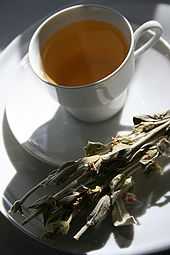Sideritis
| Sideritis | |
|---|---|
.jpg) | |
| Sideritis syriaca (Ironwort) | |
| Scientific classification | |
| Kingdom: | Plantae |
| (unranked): | Angiosperms |
| (unranked): | Eudicots |
| (unranked): | Asterids |
| Order: | Lamiales |
| Family: | Lamiaceae |
| Genus: | Sideritis L. |
| Species | |
| |
Sideritis (also known as ironwort, mountain tea and shepherd's tea) is a genus of flowering plants well known for their use as herbal medicine, commonly as an herbal tea. They are abundant in Mediterranean regions, the Balkans, the Iberian Peninsula and Macaronesia, but can also be found in Central Europe and temperate Asia.[1][2][3][4]
History and etymology
In Greek "Sideritis" can be literally translated as "he who is or has the iron". The plant was known to ancient Greeks, specifically Dioscorides and Theophrastus.[5] Although Dioscorides describes three species, only one (probably S. scordioides) is thought to relate to Sideritis. In ancient times Sideritis was a generic reference for plants capable of healing wounds caused by iron weapons during battles. However others hold that the name stems from the shape of the sepal which resembles the tip of a spear.[2]
Taxonomy

In 2002, a molecular phylogenetic study found Sideritis and five other genera to be embedded in Stachys.[6] Further studies will be needed before Stachys, Sideritis, and their closest relatives can be revised.
Some schemes recognize intermediate subphyla, infraphyla, subclasses and superorders and categorize up to 319 distinct species, subspecies, ecotypes, forms or cultivars, including:[7][2]
- S. barbellata Mend.-Heu. - endemic to the Canary Island of La Palma.
- S. candicans Aiton - endemic to the islands of Madeira, Bugio and Porto Santo.
- S. cypria Post - endemic to Cyprus
- S. hyssopifolia L. - mountains of southwestern Europe
- S. scardica
- S. purpurea Talb. - found in western Greece, the Ionian islands and Crete
- S. remota Urv.
- S. scardica Gris. - also known as Olympus tea (for its native area of Mount Olympus)
- S. theezans Boiss & Heldr - found in Peloponnese
- S. raiseri Boiss & Heldr
- S. euboea Heldr - found in the island of Euboea
- S. syriaca L., S. cretica Boiss, S. boissieri Magn. - found in Crete and collectively known as Malotira (Μαλοτήρα)
Botanists have encountered difficulties in naming and classifying the varieties of Sideritis due to their subtle differences. One particularly confusing case is that of S. angustifolia Lagasca and S. tragoriganum Lagasca.[8]
Botany
The genus is composed of short (8–50 cm), xerophytic subshrubs or herbs, annual or perennial, that grow at high altitudes (usually over 1000 m) with little or no soil, often on the surface of rocks.[1][4][9][10]
It is pubescent, either villous or coated by a fine, woolly layer of microscopic intertwined hairs.
Sideritis inflorescence is verticillaster.[1][2]
Gallery
Uses and benefits

Very popular in Greece, Albania, Bulgaria and Macedonia, the plant is used as a herb either for the preparation of herbal teas, or for its aromatic properties in local cuisines. The herbal tea is commonly prepared by decoction, by boiling the stems, leaves and flowers in a pot of water, then often serving with honey and lemon.
Ironwort has been traditionally used to aid digestion, strengthen the immune system and suppress common cold, the flu and other viruses, allergies and shortness of breath, sinus congestion, even pain and mild anxiety.
Scientists have suggested that the popular pronouncement of ironwort as panacea may have some basis in fact. Studies indicate a positive effect on many common ailments.[11] Ironwort is known scientifically to be anti-microbial, anti-inflammatory, and anti-oxidant. Active elements include diterpenoids, flavonoids, and its essential oils.[12] Significant research has been done on ironwort confirming its popular use to prevent colds, flu, and allergies. Most of this research has taken place in universities in the Netherlands and in Greece, Turkey, Macedonia, Bulgaria, and Albania, where the plant is indigenous.[13]
Cultivation
S. raeseri is the most common cultivar of Sideritis in Greece, Albania and Macedonia, where advanced hybrids also exist.[4] Planting is recommended during two periods (October–November or February–March in the Northern hemisphere) and gathering in July, when in full bloom. The plant is typically dried before usage.[14]
References
- ↑ 1.0 1.1 1.2 "Sideritis (Genus)". Zipcodezoo.com. 2013-10-04. Retrieved 2013-11-30.
- ↑ 2.0 2.1 2.2 2.3 http://www.iama.gr/ethno/sideritis/tsai_tou_vounou_files/Tsai_tou_vounou_Lora%20Prokou%20_%20Eleni_Skaltsa.pdf
- ↑ Barber, Janet C. (2000). "Evolution of Endemic Sideritis (Lamiaceae) in Macaronesia: Insights from a Chloroplast DNA Restriction Site Analysis". Systematic Botany 25 (4): 633. doi:10.2307/2666725.
- ↑ 4.0 4.1 4.2 "Greek Mountain Tea - Tsai tou Vounou - Shepherd's Tea". Greekfood.about.com. 2013-11-13. Retrieved 2013-11-30.
- ↑ "οικολογια ασπροποταμος". Aspropotamos.org. Retrieved 2013-11-30.
- ↑ Lindqvist, C.; Albert, V. A. (2002). "Origin of the Hawaiian endemic mints within North American Stachys (Lamiaceae)". American Journal of Botany 89 (10): 1709–24. doi:10.3732/ajb.89.10.1709. PMID 21665597.
- ↑ such as Wikispecies, ITIS and ZipcodeZoo
- ↑ Figuerola, R.; Stübing, G.; Peris, J. B. (1991). "Nomenclature and Typification of Sideritis angustifolia and S. tragoriganum (Lamiaceae, Spain)". Taxon 40 (1): 123–9. doi:10.2307/1222936. JSTOR 1222936.
- ↑ "τσάι του βουνου γενικές πληροφορίες". Mylona.gr. Retrieved 2013-11-30.
- ↑ Stephen Mifsud (2002-08-23). "Wild Plants of Malta & Gozo - Plant: Sideritis romana (Common Siderits)". Maltawildplants.com. Retrieved 2013-11-30.
- ↑ Tadić, Vanja; Jeremic, Ivica; Dobric, Silva; Isakovic, Aleksandra; Markovic, Ivanka; Trajkovic, Vladimir; Bojovic, Dragica; Arsic, Ivana (2012). "Anti-inflammatory, Gastroprotective, and Cytotoxic Effects ofSideritis scardicaExtracts". Planta Medica 78 (5): 415. doi:10.1055/s-0031-1298172.
- ↑ Villar, A; Recio, MC; Ríos, JL; Zafra-Polo, MC (1986). "Antimicrobial activity of essential oils from Sideritis species". Die Pharmazie 41 (4): 298–9. PMID 3523549.
- ↑ González-Burgos, E.; Carretero, M.E.; Gómez-Serranillos, M.P. (2011). "Sideritis spp.: Uses, chemical composition and pharmacological activities—A review". Journal of Ethnopharmacology 135 (2): 209–25. doi:10.1016/j.jep.2011.03.014. PMID 21420484.
- ↑ http://www.iama.gr/ethno/sideritis/tsai_tou_vounou_files/Tsai_tou_vounou_Gkoliaris_Apostolos.pdf
External links
| Wikimedia Commons has media related to Sideritis. |
Health Benefit Reports
- findarticles.com
- How to prepare Greek Mountain Tea
- florahealth.com
- actahort.org
- greekembassy.org
- greekfood.about.com
- Check the health benefits page for a free research paper
Photos:
